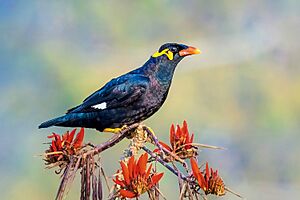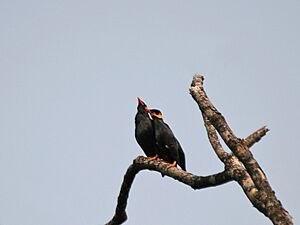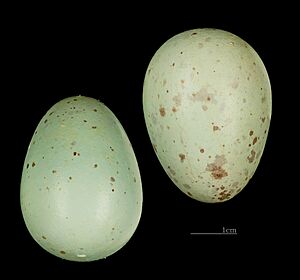Common hill myna facts for kids
Quick facts for kids Common hill myna |
|
|---|---|
 |
|
| G. religiosa at Satchari National Park, Habiganj District, Bangladesh | |
| Conservation status | |
| Scientific classification | |
| Genus: |
Gracula
|
| Species: |
religiosa
|
 |
|
| Distribution of various forms within the species complex | |
| Synonyms | |
|
Gracula indica (but see text) |
|
The common hill myna (Gracula religiosa) is a popular bird often seen as a pet. People sometimes call it simply the hill myna or myna bird. It belongs to the starling family (Sturnidae). These birds live in the hilly areas of South Asia and Southeast Asia.
Some types of hill mynas, like the Sri Lanka hill myna and the Nias hill myna, used to be considered the same species. But now, scientists generally agree they are different species. The common hill myna is famous for its amazing ability to imitate sounds, especially human speech. Its scientific name, religiosa, might come from the old practice of teaching these birds to repeat prayers.
Contents
What Does the Common Hill Myna Look Like?
This myna is a strong, black bird. It has bright orange-yellow skin patches and fleshy flaps (called wattles) on the sides of its head and neck. It is about 29 centimeters (11 inches) long. This makes it a bit bigger than the common myna you might see in cities.
Its feathers are mostly shiny black with a green tint. The head and neck can look a bit purple. When it flies, you can easily see its large white patches on the wings. But these patches are mostly hidden when the bird is sitting. Its beak and strong legs are bright yellow. The yellow wattles are on its neck and under its eyes.
These wattles look different from those on other myna birds. For the common hill myna, the wattles stretch from the eye to the back of the head, where they meet. Other types of hill mynas have wattles that look a bit different. For example, the Sri Lanka hill myna has one wattle across its neck. The southern hill myna has separate wattles that curve towards the top of its head.
Male and female common hill mynas look very similar. Young birds have a duller-colored beak.
Different Types of Common Hill Mynas
There are seven different types, or subspecies, of the common hill myna. They look only slightly different from each other. Here are some of them:
- G. r. peninsularis: This is the Bastar hill myna from central India. It is the state bird of Chhattisgarh, India.
- G. r. intermedia: Found in places like northwestern Indochina and parts of India and China.
- G. r. andamanensis: This is the Andaman hill myna from the Andaman Islands.
- G. r. religiosa: This type is found in the Greater Sundas and Peninsular Malaysia.
- G. r. miotera: This type from Simeulue Island might be extinct in the wild. This means there might be no more of them living freely in nature. Scientists are trying to save the last few in captivity.
- G. r. palawanensis: This type lives in Palawan in the Philippines.

How Common Hill Mynas Communicate
You can often hear the common hill myna because of its loud, high-pitched whistles. These calls usually go down in sound, followed by other noises. They are most vocal in the morning and evening. At these times, you can find them in small groups high in the trees at the edge of forests.
Both male and female mynas make many different loud sounds. These include whistles, wails, screeches, and gurgles. Sometimes their calls sound like music, and often they sound very much like human voices. Each bird has its own set of calls, usually between three and thirteen different types. They learn these calls when they are young. Birds living far apart, more than 15 kilometers (9 miles), might not share any of the same calls. This is like different human accents or dialects.
Unlike some other birds, common hill mynas in the wild do not copy the calls of other birds. However, when they are kept as pets, they are among the best mimics. They can learn to copy many everyday sounds, especially human speech. They can even whistle tunes with amazing accuracy.
Where Do Common Hill Mynas Live and What Do They Do?

These mynas live in many places, from India through Nepal, Bhutan, and Southeast Asia. Their range extends to southern China and the Philippines. Sadly, they are almost gone from Bangladesh. This is because their homes are being destroyed and too many are caught for the pet trade.
Common hill mynas almost always stay in trees. They move in large, noisy groups of about six birds. They hop sideways along branches. Like most starlings, these mynas eat many different things. They are omnivores, meaning they eat fruit, nectar (sweet liquid from flowers), and insects.
They build their nests in holes in trees. A female myna usually lays two or three eggs.
Pet Trade and Protecting the Birds

Hill mynas are very popular as pets because they can imitate speech so well. The common hill myna is the one you see most often in the pet trade. There are more people who want these birds than there are birds bred in captivity. So, they are often bought directly from breeders or importers. These sellers must prove the birds were traded legally.
The common hill myna is found in many places and is common in some areas. If adult birds are protected, their numbers can grow quickly. Because of this, the IUCN (a group that studies nature) says the common hill myna is a species of "Least Concern." This means it is not currently in great danger of disappearing.
However, in the 1990s, almost 20,000 wild birds were caught each year for the pet trade. In some areas, like Thailand, the number of mynas dropped a lot. To help protect them, Thailand asked for the common hill myna to be listed under CITES Appendix III in 1992. This helps control the trade. Later, in 1997, it was moved to CITES Appendix II, which gives it even more protection.
In some parts of northeastern India, the myna is becoming rare. This is due to birds being caught for the illegal pet trade. But in the Garo Hills region, local people have found a way to help. They make special nests out of bamboo and grass. They put these nests in tall trees in forest clearings. This encourages the mynas to breed there.
This way, villagers can collect the young birds at the right time to raise them by hand. This makes common hill myna farming a small, profitable business. It also helps the environment. The adult birds are not removed from the wild population. Also, people protect the forests because mynas prefer natural forests over cut-down areas. If there are too many mynas, they can sometimes eat too much fruit. This method also helps control the myna population. If numbers are low, people put out fewer nests. If numbers are high, they take more young birds.
See also
- Talking birds



